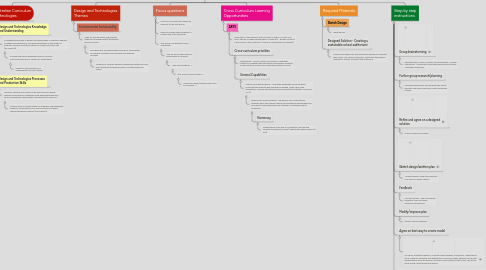
1. Step by step instructions
1.1. Group brainstorming
1.1.1. Generate ideas, clarify concepts, seek possibilities, consider alternatives - collaborative work developing a basis for their sustainable auditorium
1.2. Further group research/planning
1.2.1. Extending above ideas and deciding their worth; generate new ideas; research current sustainable designs
1.3. Refine and agree on a designed solution
1.3.1. Group consensus of design
1.4. Sketch design/written plan
1.4.1. Visualise design; make improvements; form basis of model creation
1.5. Feedback
1.5.1. Hot seat activity - peer and teacher feedback; class and group discussion/questioning
1.6. Modify/improve plan
1.6.1. Based on above feedback
1.7. Agree on best way to create model
1.7.1. 3D model, annotated diagram, computer based program, storyboard - awareness of group members strengths and weaknesses is necessary when agreeing on the best representation so all students are involved in the creating of the model. This will be done during Visual/Media Arts lessons.
1.8. This planning process will be extended over several lessons so students have an opportunity to progress through these steps and to continually improve, evaluate and reflect on their design and its success.
2. Australian Curriculum Technologies
2.1. Design and Technologies Knowledge and Understanding
2.1.1. Investigate how people in design and technologies occupations address competing considerations, including sustainability in the design of products, services and environments for current and future use (ACTDEKO19)
2.1.1.1. Consider the impact designed products, services or environments have in relation to sustainability
2.1.1.1.1. Reflect on the importance of sustainability in product design
2.2. Design and Technologies Processes and Production Skills
2.2.1. Generate, develop and communicate and document design ideas and processes for audiences using appropriate technical terms and graphical representation techniques (ACTDEP025)
2.2.1.1. Critique needs or opportunities for designing, and investigate materials, components, tools, and processes to achieve intended designed solutions (ACTDEP024)
3. Cross Curriculum Learning Opportunities
3.1. ARTS
3.1.1. Application of the elements and principles of design in Visual Arts and in the use of digital technologies in Media Arts - groups construct a final model of the auditorium (variety of representations available)
3.1.2. Cross-curriculum priorities
3.1.2.1. Sustainability - school auditorium provides an authentic context for creating preferred futures and prepares students to take action to create more sustainable patterns of living
3.1.2.2. General Capabilities
3.1.2.2.1. Critical and creative thinking - during the designing process students collaboratively generate and evaluate knowledge, clarify ideas, seek possibilities, consider alternatives and solve problems (Australian Curriculum, 2013)
4. Design and Technologies Themes
4.1. Environmental Sustainability
4.1.1. Need for environmental sustainability (especially building design) identified in previous lessons
4.1.1.1. Recognise that the development and use of technologies can develop solutions and contribute to sustaining societies
4.1.1.1.1. Students to consider desirable sustainable patterns of living, and contribute to preferred futures for themselves and others
5. Required Materials
5.1. Sketch Design
5.1.1. paper/pencils
5.2. Designed Solution - Creating a sustainable school auditoriumi
5.2.1. Materials will depend on how the groups decides to represent their model. May require computers, storyboard templates or materials to actually construct the auditorium.
6. Focus questions
6.1. How will your auditorium design be different to the next group?
6.2. Does your design show evidence of creative and critical thinking?
6.3. Why would your design be more sustainable?
6.3.1. How will your design improve sustainability of schools?
6.3.1.1. Have you thought of....?
6.3.1.1.1. Why did your group decide ....?
